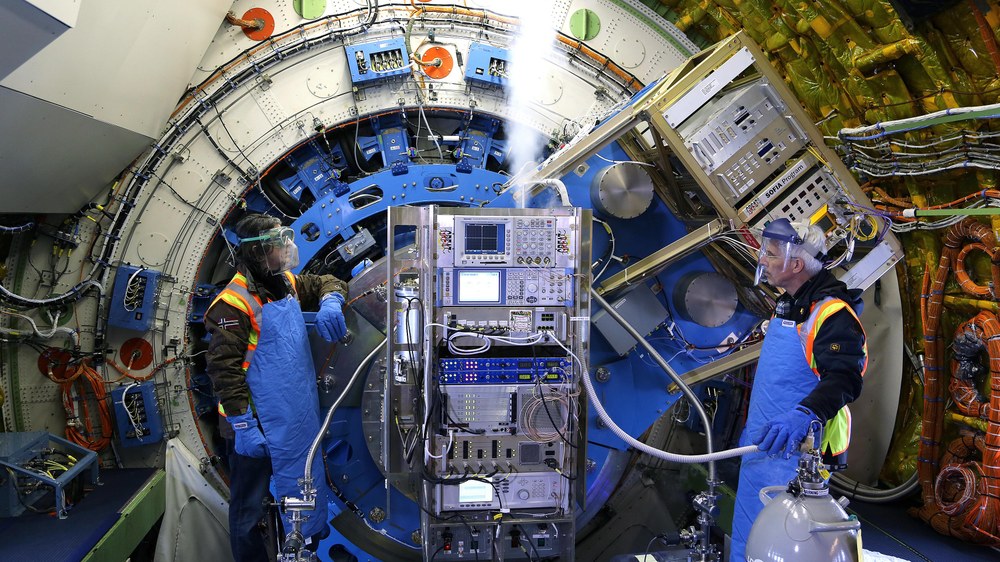SOFIA airborne observatory – NASA and DLR extend cooperation agreement at ILA



The SOFIA (Stratospheric Observatory for Infrared Astronomy) airborne observatory – a joint venture between the German Aerospace Center (Deutsches Zentrum für Luft- und Raumfahrt; DLR) and the United States National Aeronautics and Space Administration, NASA – explores the evolution of galaxies using the telescope. Since 2011, the hatch of the modified Boeing 747SP has been opened 250 times to observe the night sky. The numerous 10-hour-long flights have been so prosperous that DLR and NASA have extended SOFIA's service life – initially until the end of 2020. The agreement was signed on 2 June 2016 by the Chair of the DLR Executive Board, Pascale Ehrenfreund, Gerd Gruppe, Member of the DLR Executive Board responsible for the Space Administration, and Dava Newman, Deputy Administrator of NASA, at the ILA Berlin Air Show.
SOFIA – a classic example of German-US collaboration
"SOFIA is a classic example of the many years of successful collaboration between NASA and DLR in the field of space exploration research," said Ehrenfreund during the signing in Berlin. "We're pleased to be making this globally unique observatory available to astronomers for their research for an initial period of four more years," added Gruppe. The extension of the agreement is also a milestone for NASA: "SOFIA's unique capabilities for observing the universe in the mid and far infrared will be unparalleled for many years to come. The breakthrough science from this one-of-a-kind flying observatory will help unravel the mysteries of our cosmos, and complement the discoveries of the upcoming James Webb Space Telescope," said Newman.
Fit for duty until 2030
The airborne observatory measures the thermal emission from space that is not visible from Earth. Its observations therefore focus on the evolution of galaxies – in particular, the Milky Way. SOFIA mainly explores molecular and dust clouds in galaxies, where new stars and planetary systems are formed. The airborne observatory has therefore been designed – and regularly maintained – to ensure its missions until 2030. Its measuring instruments are also continuously being enhanced and/or replaced by modern, more efficient versions. Based on regular reviews of the scientific results, NASA and DLR will decide on a further service life extension from 2018.
German research set to continue
The collaboration and allocation of responsibilities between the two partners is managed by means of a cooperation agreement – a Memorandum of Understanding (MoU). The original MoU concluded at the end of 1996 for a period of 10 years, to manage the development and construction of the infrared telescope by DLR, and its installation in the Boeing 747SP modified by NASA. In late 2006, the MoU was extended for another 10 years, to cover the intensive test phase and initial scientific observations. In addition to providing the telescope, Germany also has a 20 percent share in the operation of the observatory – 20 percent of the observation time is therefore allocated to scientists from German research institutes. Scientists now have a total of seven measuring instruments at their disposal, including cameras and spectrometers; their use in the institutes is also financed by funding from NASA and DLR. German scientists can now continue to use this technology and carry on exploring the evolution of galaxies until 2020 and beyond.
SOFIA
The Stratospheric Observatory For Infrared Astronomy (SOFIA), is a joint project operated by the German Aerospace Center (Deutsches Zentrum für Luft- und Raumfahrt; DLR) and the National Aeronautics and Space Administration (NASA). The German contribution to the project is managed by the DLR Space Administration, using funds provided by the Federal Ministry for Economic Affairs and Energy (Bundesministerium für Wirtschaft und Energie), the State of Baden-Württemberg and the University of Stuttgart. Development of the German instruments is financed using funds from the Max Planck Society (Max-Planck-Gesellschaft; MPG), the German Research Foundation (Deutsche Forschungsgemeinschaft; DFG) and DLR. The scientific operations are coordinated by the German SOFIA Institute (Deutsche SOFIA Institut; DSI) at the University of Stuttgart on the German side, and by the Universities Space Research Association (USRA) on the American side.
